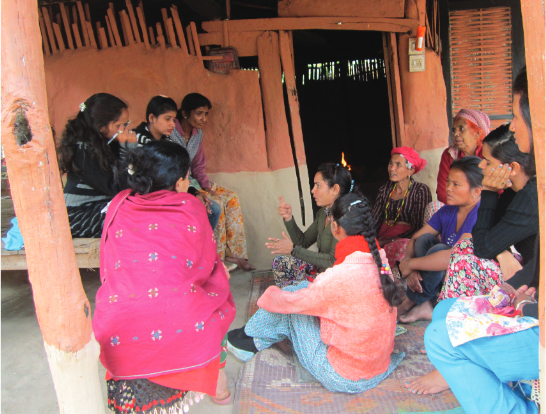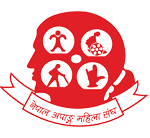
Team members of NDWA talking with villagers.
Current Situation
The majority of women in Nepal are discriminated across gender lines, and the patriarchal nature of Nepalese society has pushed Nepalese women to lag behind in several socio-economic dimensions. WWDs face historical exclusion and multiple deprivations in all spheres of life and also in development endeavors. People do not comprehend disability from a social and human rights perspective. The family or the community considers disability as a disease and illness that even disables the productivity and their capacity. The generally perceived thinking is that disability is a result of sin they committed in their previous life. As a result, WWDs are facing double discrimination (gender and disability) or even more when other forms of discrimination such as caste or geographical remoteness is coupled with. Disability has been a major cause to prevent WWDs from getting married which leads them to face social stigma. Despite the high potentialities and capacity WWDs possess, they face difficulty to be accepted that they can also contribute to the building of family and society.
- Multiple discrimination: Gender identity, disability and poverty. Other issues; caste, HIV/AIDs geographical remoteness further deteriorates the situation
- Conceptual barriers: (mindset, language, treating as object, unproductive and unskilled resource, therefore needing no investment)
- WWDs and Violence: Physical-80%, sexual- 50%, domestic-60%, verbal harassment- 30%. (source: According to NDWA research report 2007)
- Legal barriers: Existing laws are either discriminatory or do not provision rights for WWDs.
- Deprived from opportunities, socially, politically and economically unsecured and suffering from inferiority complex.
- Lack of mechanisms to promote or protect rights of WWDs
- WWDs and their issues have not been the agenda for general women movement
- Poor general health & reproductive health condition of WWDs
- Women with Disabilities Movement in Nepal:
- From early 1990, after the re-instatement of democracy along with freedom to get organized
- In order to effectively address the issues of WWDs, an ‘Off organization’ felt necessary
- As a result NDWA was established in 1998 lead by the all kind of WWDs
- Main focus has to develop the capacity of WWDs along with advocating for the rights i.e. education, health/reproductive health, livelihood, rehabilitation & social security, against violence, representation/participation NDWA is a better position to develop networking and coordination among Disabled people’s organizations, Women organizations, human rights organizations, others networks & alliances
Women with Disabilities Movement in Nepal:
- From early 1990, after the re-instatement of democracy along with freedom to get organized
- In order to effectively address the issues of WWDs, an ‘Off organization’ felt necessary
- As a result NDWA was established in 1998 lead by the all kind of WWDs
- Main focus has to develop the capacity of WWDs along with advocating for the rights i.e. education, health/reproductive health, livelihood, rehabilitation & social security, against violence, representation/participation
- NDWA is a better position to develop networking and coordination among Disabled people’s organizations, Women organizations, human rights organizations, others networks & alliances

 English
English